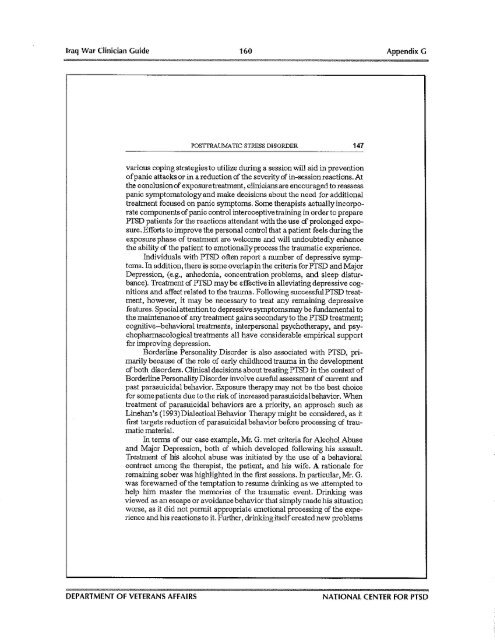IRAQ WAR CLINICIAN GUIDE
Iraq War Clinician's Guide - Network Of Care
Iraq War Clinician's Guide - Network Of Care
You also want an ePaper? Increase the reach of your titles
YUMPU automatically turns print PDFs into web optimized ePapers that Google loves.
Iraq War Clinician Guide 160 Appendix G<br />
~osrnu~~nc STRESS DISORDER<br />
147<br />
various coping strategiesto utilize during a session will aid in prevention<br />
ofpanic attacks or in a reduction of the severity of in-session reactions. At<br />
the conclusionof exposure treatment, cliniciansare encouraged to reassess<br />
panic symptomatology and make decisions about the need for additional<br />
treatment focused on panic symptoms. Some therapists actually incorporate<br />
componentsof panic control interoceptive training in order to prepare<br />
PrSD patients for the reactions attendant with the use 6prolonged exposure.<br />
Efforts to improve the personal control that apatient feels during the<br />
exposure phase of treatment are welcome and will undoubtedly enhance<br />
the ability of the patient to emotionally process the traumatic experience.<br />
Individuals with PTSD often report a number of depressive symptoms.<br />
In addition, there is some overlapin the criteria for PTSD andMajor<br />
Depression, (e.g., anhedonia, concentration problems, and sleep disturbance).<br />
Treatment of PTSD may be effective in alleviating depressive cognitions<br />
and affect related to the trauma. Following successfulPTSD treatment,<br />
however, it may be necessary to treat any remaining depressive<br />
features. Specialattentionto depressivesymptomsmay be fundamental to<br />
the maintenanceof any treatment gains secondruyto the PTSD treatment;<br />
cognitive-behavioral treatments, interpersonal psychotherapy, and psychopharmacologicaltreatmentsall<br />
have considerable empirical support<br />
for improving depression.<br />
Borderline Personality Disorder is also associated with RSD, primarily<br />
because of the role of early childhood trauma in the development<br />
of both disorders. Clinical decisions about treating PTSD in the context of<br />
Borderline Personality Disorder involve careful assessment of current and<br />
past parasuicidal behavior. Exposure therapy may not be the best choice<br />
for some patients due to the risk of increased parasuicidalbehavior. When<br />
treatment of parasuicidal behaviors are a priority, an approach such as<br />
Linehan's (1993)Dialectical Behavior Therapy might be considered, as it<br />
fmt targets reduction of parasuicidal behavior before processing of traumatic<br />
material.<br />
In terms of our case example, Mr. G. met criteria for Alcohol Abuse<br />
and Major Depression, both of which developed following his assault.<br />
Treabnent of his alcohol abuse was initiated by the use of a behavioral<br />
contract among the therapist, the patient, and his wife. A rationale for<br />
remaining sober was highlighted in the fust sessions. In particular,Mr. G.<br />
was forewarned of the temptation to resume drinking as we attempted to<br />
help him master the memories of the traumatic event. Drinking was<br />
viewed as an escape or avoidance behavior that simply made his situation<br />
worse, as it did not permit appropriate emotional processing of the experience<br />
and his reactions to it. Further, drinking itself created new problems<br />
DEPARTMENT OF VETERANS AFFAIRS<br />
NATIONAL CENTER FOR PTSD




